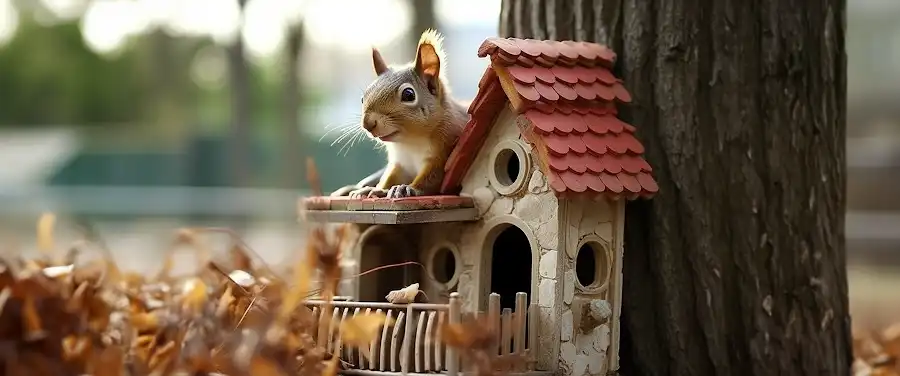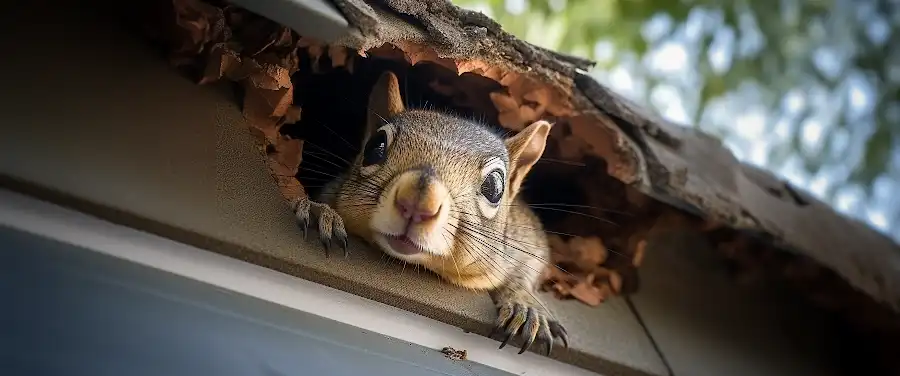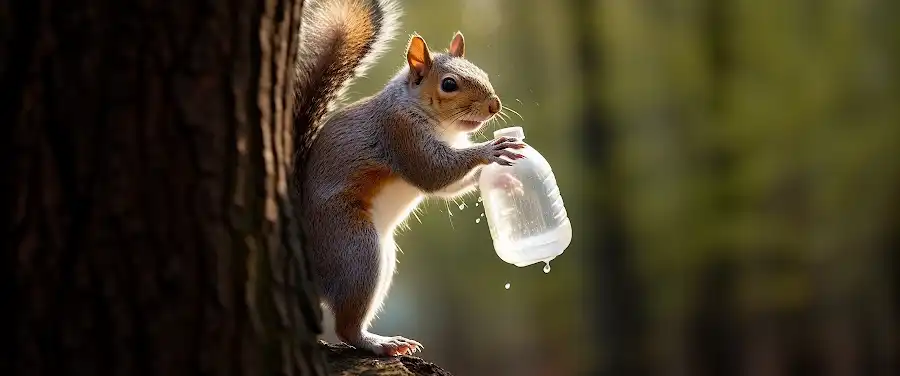
If anyone told you that a gang is living in your house, you’d probably freak out, right? Brace yourself! There might just be a ‘fuzzy-tailed’ gang squatting right under your nose. Yes, we’re talking about squirrels! Before you start imagining animated movie characters holding tiny meetings in your attic, let’s keep it real – the reality of a squirrel infestation isn’t quite as endearing.
Peeking into the world of these tiny acrobats, we will unravel the signs that paint a truer picture of when and why these cute outlaws decide to turn your home into their big nut store. With a better grasp of understanding squirrels, their behavior, and the tell-tale signs they leave behind, you can be better prepared and effective in your squirrel infestation management.
So, if you find an odd nut or two hidden in your shoes, or hear rustling and running across your ceiling in the middle of the night, quit dismissing it as mere household quirks. It’s time to put your Sherlock hat on and hunt for clues. Keep reading as we get into the thick of things, helping you understand the signs of a squirrel infestation. You might even be surprised to discover their ‘secret headquarters’ stashed away in the nifty corners of your home. Intrigued? Wait until you find out why they picked your home in the first place! Let’s uncover these mysteries as we venture into a question as adventurous – “Under What Circumstances Do Squirrels Invade Human Homes?”
What Are the Common Signs of a Squirrel Infestation?

Whether it’s the unmistakable sound of scampering or scratching in your attic, larvae-infested droppings, or mysterious gnaw marks on wires and wooden structures – the presence of squirrels in your humble abode can be a true nightmare. Let’s dive into the tell-tale signs of a squirrel infestation and various indicators that these bushy-tailed creatures have made your house their new home.
Firstly, take note of any physical signs like squirrel droppings or gnaw marks. Squirrel droppings can be identified by their dark brown color and oblong shape – similar to a large grain of rice. Gnaw marks, typically found on wooden structures, wires, or food containers, also hint at a potential squirrel problem. Squirrels have sharp teeth designed to gnaw and nibble which can lead to significant damage to your house.
Next, tune your ears to distinctive squirrel sounds. This typically includes loud scampering sounds during the day, particularly early in the morning or just before sunset. You might also occasionally hear scratching noises from your walls or ceiling. These noises are often the most obvious sign that squirrels have invaded your space.
Look for the presence of squirrel nests within your home, particularly in your attic or roof space. Squirrels construct their nests by fetching materials like leaves, twigs, and insulation from your home, which may not only lead to functional damage but can even pose a fire risk.
Lastly, be on high alert for food pilfering. If you spot scattered food particles, especially around bird feeders or your garden, it’s likely that squirrels have been siphoning off your supplies. Infrequent missing food might not ring alarm bells, but a consistent pattern definitely indicates a squirrel problem.
| Common Signs of Infestation | Indications |
|---|---|
| Squirrel Droppings | Dark brown, oblong shape |
| Gnaw Marks | Visible on wooden structures or food containers |
| Squirrel Sounds | Scampering or scratching noises |
| Squirrel Nests | Tree-like structures in the attic or roof space |
| Food Pilfering | Scattered food particles or missing food |
What Types of Damages Can Result from a Squirrel Infestation?
If you notice any of the infestation signs mentioned above, swift action is necessary. Leaving a squirrel infestation unresolved can result in significant structural damage to your home – a cost you surely wish to avoid. Squirrels, with their gnawing habits, can damage wooden beams, walls, electrical wires, and more. In fact, gnawing on electrical wires can create a fire hazard.
The damage, however, doesn’t end there. Squirrels are well known for their destructive nature and harming insulation structures for their nests. Insulation damage in the attic can have a negative impact on your home’s energy efficiency and also pose a health risk due to the droppings and urine they leave behind.
Speaking of health risks, squirrel infestations can lead to serious health risks. Squirrel feces and urine can be vectors for Salmonella and Leptospirosis – both of which can cause serious illness.
Remember, the longer a squirrel infestation lasts, the more severe these damages can become – affecting not only your property but potentially putting the health of your family at risk.
As seasons change, so do squirrel behaviors, which greatly influences their infestation patterns. But we’ll cover more of that later, in “How Do Different Seasons Affect Squirrel Infestations?” Stay tuned!
How Do Different Seasons Affect Squirrel Infestations?

It’s fascinating (and a tad unnerving) how the change in seasons can impact squirrel infestations. But why is that important to you? Well, by understanding these seasonal shifts, you can better prevent and protect your home from these bushy-tailed invaders. So, let’s dig in before they do!
Most squirrels are active all year, but their behavior drastically changes during different seasons. One major change to observe is their rampant food hoarding behavior in autumn when they’re busily stocking up for winter. This often leads them to seek shelter inside homes to protect their food cache and to stay warm themselves. Thus, winter infestations tend to be pretty common.
Furthermore, squirrels breed during late winter and once again in mid-summer. This breeding pattern results in increased squirrel populations, and hence, the possibility of a surge in infestations. The spring risk is further fueled by the birth of young squirrels seeking nesting grounds during this time. Essentially, it’s a squirrel-infested merry-go-round!
How Do Climate Shifts Affect Squirrel Infestation Patterns?
Climate change is a hot potato topic right now, and humans aren’t the only ones being affected. Squirrels too have their habits altering and nesting patterns changing in response to shifts in climate.
As weather patterns become more unpredictable, so do the behaviors of squirrels. For instance, milder winters might lead to an increased survival rate for young squirrels, leading to a higher overall population – pretty worrying for homeowners!
Furthermore, the squirrel diet primarily consists of nuts, seeds, and plant matter. When these food sources become scarce due to climate change-related fluctuations, squirrels are drawn to new areas to find sustenance. Unluckily, this often ends up being our yards and homes leading to unprecedented food supply shifts.
According to a study by the Yale School of Environment, beetle infestations and prolonged droughts have considerably altered forest ecosystems, thereby affecting the availability of squirrel food sources. So essentially, climate changes are definitely messing up everyone’s schedule – including squirrels’.
As you comprehend these dynamics, you will be better prepared to address the nuances that come with these infestations. Now that you have a fair understanding of the impacts of season changes and climate shifts, let’s hop on to the preventive measures you can adopt to combat a squirrel infestation. Stay tuned, it gets more interesting!
Conclusion
Knowing the signs of a squirrel infestation and acting promptly can save you from a lot of trouble. These cheeky creatures can cause catastrophic damage to your home if left unattended. From nasty nibbles on your furniture to unwelcomed chewing on your cables, squirrel infestations are more than just an inconvenience – they’re a costly nightmare.
Early detection and prevention are your best allies in this battle. Monitor signs of squirrel activity closely. You might think those scurrying noises in your attic or nibbled plants in your backyard are just innocent happenings, but they might be hinting at a more serious issue.
Don’t take these signs lightly. The least you want is a horde of squirrels turning your home into their playground, chewing away your peace of mind. Don’t wait until it’s too late. Take proactive steps to ensure your home stays squirrel-free. Regular inspections and routine maintenance can make a world of difference.
But what if you’re unable to handle the squirrel problem yourself? There’s no need to fret. Professional help is always available to give you a hand. Pest control experts can efficiently manage squirrel infestations, ensuring your house gets back to its normal, squirrel-free state.
Remember, costs for repairs can escalate quickly if damage from squirrels are left unchecked. Equipped with the knowledge of the telltale signs of a squirrel infestation, you can act quickly at the first hint of trouble. Because, after all, having a squirrel family over as uninvited guests is definitely not worth the headaches!
So, take action today. Keep an eye out for these signs, reinforce your house against any potential intrusions, and don’t hesitate to seek professional help when needed. An interference free home awaits you!
Remember, preparation and prevention can go a long way to ensuring your home is free from squirrel problems.




